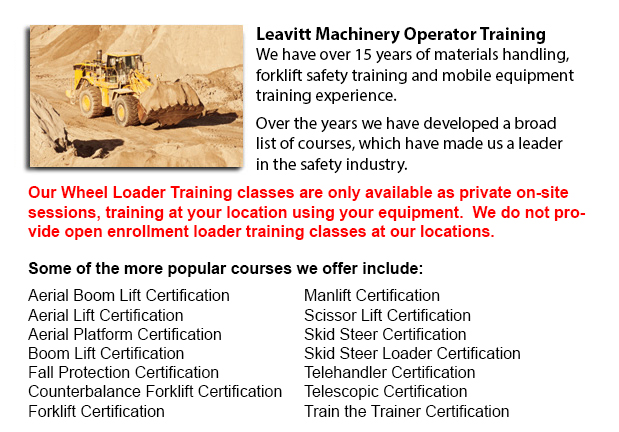
Ontario Wheel Loader Operator Training - To be able to pick up significant loads, industrial cranes use pulleys and levers. In the past, Romans used cranes to build huge monuments making the origin of these equipment at least 2,000 years ago. Many Medieval churches utilized cranes in their construction and the Egyptians may have relied on them when building the pyramids.
The new version of a crane could be either complex or simple, and cranes differ based on their function. Mobile cranes, for instance are somewhat simple. A telescopic boom or steel truss mounts its movable platform. A system of levers or pulleys lifts the boom and there is usually a hook suspended. These cranes are often used for demolition or earthmoving by changing the hook out with one more piece of gadget like for example a wrecking ball or a bucket. Telescopic cranes have a series of hydraulic tubes that fit together to form the boom. These models can even be mobile.
Conventional wheels, or specialized wheels meant for a caterpillar track or railroad track allow these mobile booms to be able to navigate unpaved and uneven surfaces.
Truck mounted and rough terrain cranes are mobile also. Outriggers are situated on the truck mounted unit in order to enhance stability, while rough terrain cranes include a base that tends to resemble the bottom of a 4-wheel drive. These cranes are outfitted to be able to work on rough surface making them best in the construction trade for example.
Gantry cranes are actually utilized in order to transport and unload big containers off of ships and trains. They are most often found operating in ports and railroads. Their bases consist of huge crossbeams that run on rails so as to raise containers from a location to another. A portainer is a special type of gantry that transports supplies onto and off of ships specifically.
Important to the shipping trade, floating cranes could be connected on barges or pontoons. Being located in water, they are excellent for use in salvaging ships, building bridges and port construction. Floating cranes can handle really heavy cargo and containers and similar to portainers, they can even unload ships.
Loader cranes include hydraulic powered booms that are fitted onto trailers so as to load stuff onto a trailer. The jointed sections of the boom could be folded down whenever the machine is not in use. This type of crane can be even considered telescopic in view of the fact that one part of the boom can telescope for more versatility.
Stacker cranes are normally found in automated warehouses. They tend to follow an automated retrieval system and can function by remote. These cranes are outfitted with a forklift apparatus and could be found in huge automated freezers, obtaining or stacking foodstuff. Using this type of system enables employees to remain out of that freezing situation.
Tower cranes, normally the tallest kind, usually do not have a movable base. They must be assembled part by part. Their base resembles a long ladder along with the boom at right angles to the base. These cranes specialize in the construction of tall buildings and are often affixed to the inside of the building itself during the construction period.
-
Ontario Manlift Certification
Ontario Manlift Certification - The Elevated Platforms and Manlifts Certification course helps to provide the required training on the work practices, safe operating procedures, regulations and rules regarding the everyday activities for the operator... More -
Ontario Crane Training
Ontario Crane Training - Bridge cranes or overhead cranes are actually a type of industrial material handling crane making use of a line and hook mechanism that runs on a horizontal beam running along two widely separated rails. Various overhead cran... More -
Ontario Aerial Lift Train the Trainer
Ontario Aerial Lift Train the Trainer - The Aerial Lifts Train the Trainer Certification Program teaches trainers how to effectively train operators in safe industrial mobile machinery operation. Trainers are given in-depth instruction about aerial l... More -
Ontario Warehouse Forklift Training Classes
Ontario Warehouse Forklift Training Classes - The reason for warehouse training classes are to raise the awareness of common workplace dangers. The trainees will learn essential warehouse safety procedures. An emphasis is placed on paying attention t... More -
Ontario Forklift Training School
Ontario Forklift Training School - Forklift Training School - Industry and federal regulators have established the criteria for forklift safety training based on their current standards and regulations. Those wanting to operate a forklift must finish... More -
Skid Steer Loader Training in Ontario
The engine powered skid-steer loader consists of a rigid and small frame, equipped along with lift arms that could attach to lots of industrial tools and attachments to execute many labor saving jobs. Normally, skid-steer loaders are four-wheel drive... More -
Ontario Crane License
Ontario Crane License - Crane operators ought to be "credentialed", that means they ought to own a crane operator certification or license. Credentialing is considered a mandatory governmental requirement to be able to practice as an operator of a cr... More -
Ontario Forklift Operator Training
Ontario Forklift Operator Training - Forklift training is a prerequisite in North America and is intended to prevent workplace injuries and death. Forklift training offers driver training intended for forklift operators. Training programs teach the s... More

Forklift Certification Ontario
TOLL FREE: 1-888-254-6157
Toronto, Ontario
forkliftcertificationontario.com
Email Us
About Us


